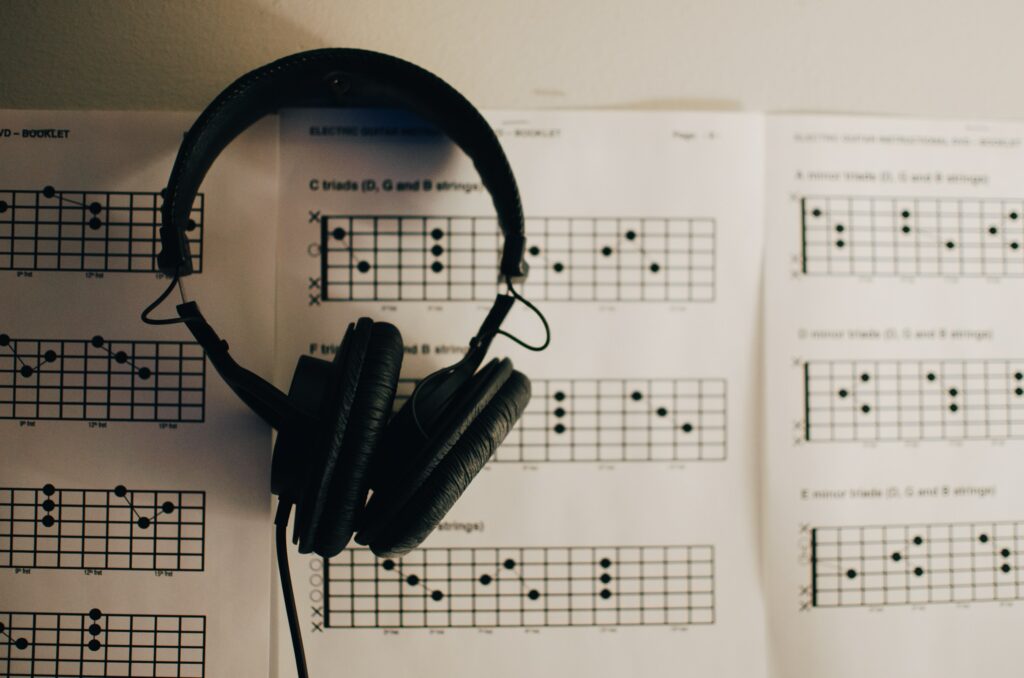Think of your favorite song—what do you like most about it? The lyrics? The melody? The baseline hidden beneath the final mix?
A song is much like a poem written to the movement of a melody—imagery, harmony, and simile merge to relate creator to consumer in a way that transcends the use of words alone.
Simply put, a song is a combination of thoughtfully constructed parts that, once put together, amplify one another.
Let us begin with the cornerstone.
Topic and theme: What are we talking about again?
When writing a song, you can talk about anything—grief, triumph, planes, the noise a fox makes—but what makes a song unique to the writer is how that person decides to respond to the context of the topic.
Think of the topic of love: it’s February, shops and restaurants are covering their windows with pink and red hearts and decorating their walls with tapestries to match. This is the color of the season through the eyes of Western society. So how are you going to respond?
You could easily start as such:
You’re my rose on Valentine’s
Simple. Classic. Cliché. We, as readers, are fully aware of the traditions of this season, and we have seen this connection time and time (and time) again! But you can also decide to continue the first verse by playing with the audience’s expectations:
You’re my rose on Valentine’s
Sweet as the Summer and
Covered in thorns.
I see…there’s some complexity to this relationship now. Anyone who reads these next two lines may begin to wonder why the speaker is saying this about a significant other, or why the speaker would continue to remain in an unfulfilling relationship. Thus, you’ve begun to develop a theme, so stick with it and elaborate until the picture is clear. This will become the first draft (yes, first draft) of your lyrics.
A quick note: irony doesn’t have to be the foundation of a nuanced song. A beautiful example of a fresh take on the topic of love would be JVKE’s “Golden Hour,” which utilizes the cultural phenomenon of the “golden hour” to emphasize the radiance emulated by the significant other. In such an example, it is the context and expectation of the audience that makes the song stand out more, rather than the element of lyrical irony.

Chord progression: Setting the mood
Music Theory 101: chords can convey varying emotions based upon the type and sequence of chords played. Minor chords are somber, major chords are joyful, diminished chords are tense, etc.
The chord progression itself refers to the sequence of chords played and repeated throughout the course of a song. This could be as simple as a single chord, or as complex as five, and the chord progression tends to influence how the audience perceives the message of your piece.
Back to the cornerstone: love. For a more cliché approach, you might be drawn toward using a more cheerful, major chord progression. But let’s dig in a little deeper.
Music Theory 201: By using some contrast, especially tied with the irony of the song, you can achieve more interesting effects. If you set the three lines to the harmony of an A-minor chord, the audience will immediately infer that the theme takes a turn for the worse. The dramatic effect of the irony is lessened as a result of thematic continuity. If you set to the harmony of A-major, the audience would see the lines as out of place against the joyfulness, creating tension by amplifying irony. Furthermore, if you were to play the two chords in progression—transitioning from the minor to the major—you would communicate a sense of hope despite the intensity of the lyrics.
Each method of combination has its strengths and weaknesses, compromising one aspect to emphasize another. The beauty of this is the freedom of interpretation. You can set and shift the mood of your song as you please depending on your intentions for the song. Feel free to experiment!

Sweet melody: That thing that’s stuck in your head
While I’ve begun to discuss the birth of the lyrics and instrumental, I have neglected to address the way in which the two prominently interact—melody.
As an avid consumer of international music, I’ve grown to appreciate a good melody. If done well, the melody can interact with the chord progression in a way that amplifies the intended theme and impacts the listener aesthetically. This masterful use of interplay is largely why a catchy chorus maintains permanent residence in your short-term memory.
First and foremost, the melody interacts with the chord progression directly. The notes sung (or played) add a level of complexity to the chord, and it is your choice what that complexity will be. This concept can, by and large, be heard while creating the melody, but it may be helpful to ask yourself this question before you create:
What do you want the audience to focus on?
If you have not noticed, we’re back to our cornerstone. Consider your theme and emphasize the words or images that are most important. This can be as simple as slowing down the melody when you get to a shocking metaphor or singing a higher note at the end of a key phrase. Creating a sense of tension with contrast (high v. low; fast v. slow; minor v. major) is a surefire way to center your audience’s focus on the parts of your song that reveal the theme.
And when all else fails, create a melody that sounds good to you. If you enjoy it then someone else is bound to as well.

Try and Try and Try
As I have said before, the lyrics—as well as all other aspects of the song—are a drafting process. In all honesty, the song may not sound good to you at first. That’s completely normal. What matters most is perseverance through the process. Chords can be arranged in millions of ways, unique imagery is impossible to make, and the melody is not a feat for the faint of heart. Nonetheless, songwriting is a beautiful expression of creativity with the power to connect people across various countries and cultures. A worthy task, I’d say!
So let’s sit at the piano stool, grab a pen and piece of paper, and try.